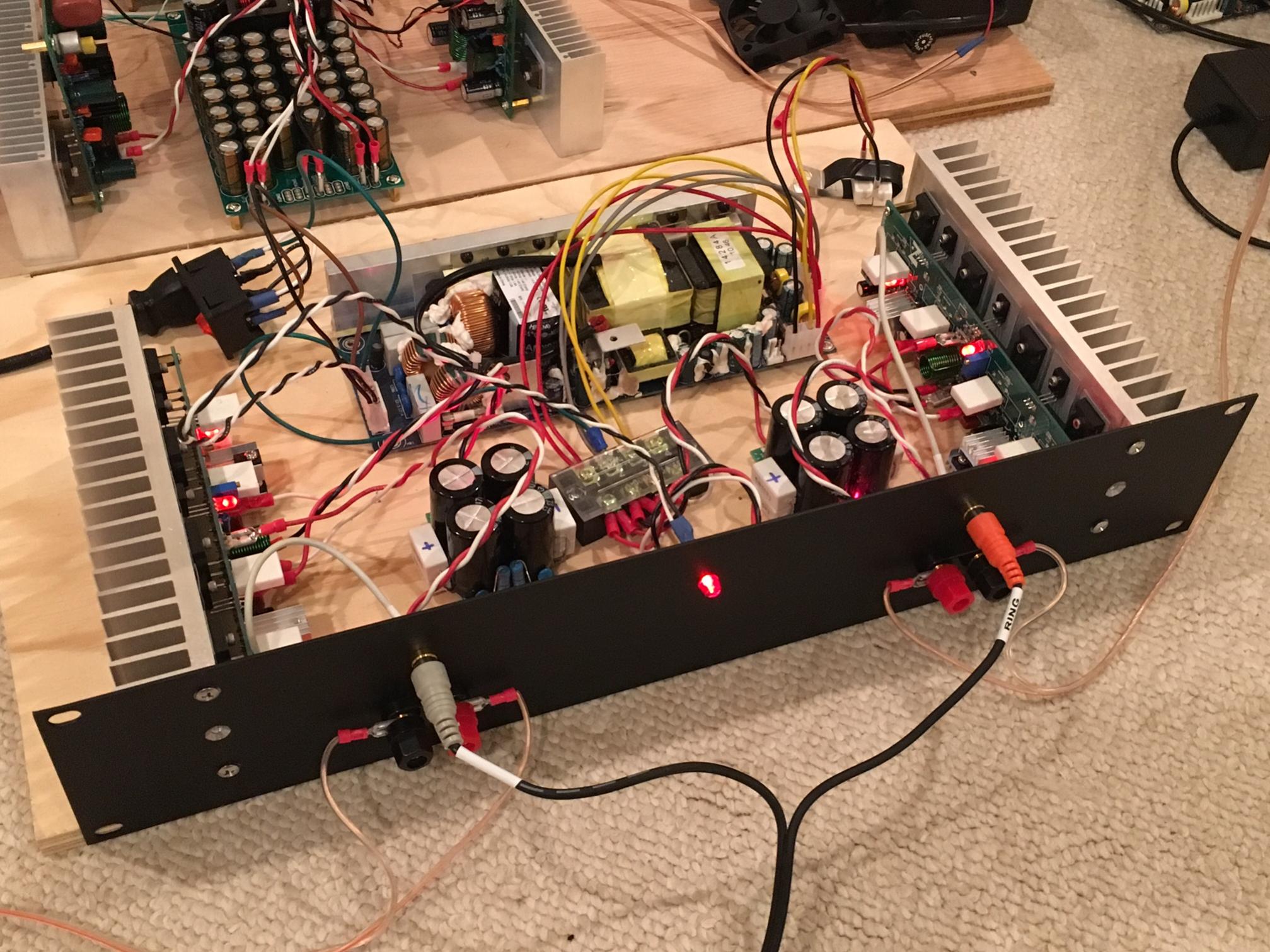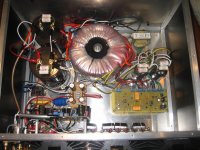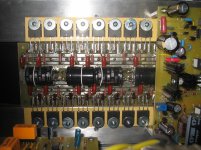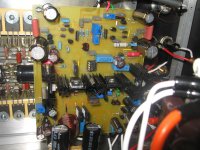Thanks ASKA for your input, appreciated. I'm not designing the circuit myself, but I'm using a proven circuit. I'm doing the mechanical assembly, and some support PCB. As for the complexity of the design, I built my VSE RTP3C tube preamp all point to point, can't beat that for complexity. It took me two years part time!
For the record the output stage is using MOSFET, and no source resistor...
I know, I know some think it is foolish to do so but Borbely did it, Goldmund do it to. The amp needs to be well protected, DC offset, current overload, fast over temp ctuoff, fast MOSFET switch disconnect power supplies, etc...
I built a pair of Borbely Millenium monoblock power amps, with 70V rail, 6 pairs of MOSFET output stage, 200W in 8 ohms, 1KVA power transformer, Plitron LoNo. Real beasts, two people lift boat anchor... Included some pictures.
One of my friend has a pair, driving Wilson Audio speakers. They are the best amp we ever heard, power, control, speed, but still delicacy. They are only best by my PassLabs XA30.8 clone, that has more midrange lush, but less control, and way more heat. It is my winter amp 😎
I like complex projects, things to do during the long canadian winter 😉
For the record the output stage is using MOSFET, and no source resistor...
I know, I know some think it is foolish to do so but Borbely did it, Goldmund do it to. The amp needs to be well protected, DC offset, current overload, fast over temp ctuoff, fast MOSFET switch disconnect power supplies, etc...
I built a pair of Borbely Millenium monoblock power amps, with 70V rail, 6 pairs of MOSFET output stage, 200W in 8 ohms, 1KVA power transformer, Plitron LoNo. Real beasts, two people lift boat anchor... Included some pictures.
One of my friend has a pair, driving Wilson Audio speakers. They are the best amp we ever heard, power, control, speed, but still delicacy. They are only best by my PassLabs XA30.8 clone, that has more midrange lush, but less control, and way more heat. It is my winter amp 😎
I like complex projects, things to do during the long canadian winter 😉
Attachments
Last edited:
Plitron probably don't make a 110Vac primary. I suspect they make a 115Vac primary, or dual 115Vac primary.
These can be used for any supply voltage from 110Vac to 120Vac and the tolerance beyond these nominal voltages.
Antek specify their transformers in a non stanard way. Fortunately they give some test data to let the Builder arrive at some numbers that allows compareson to the normal method of specifying a mains transformer.
Read what they have published about the transformer selected and see if you can arrive at the normal Primary:Secondary voltages and the transformer regulation plus VA.
These can be used for any supply voltage from 110Vac to 120Vac and the tolerance beyond these nominal voltages.
Antek specify their transformers in a non stanard way. Fortunately they give some test data to let the Builder arrive at some numbers that allows compareson to the normal method of specifying a mains transformer.
Read what they have published about the transformer selected and see if you can arrive at the normal Primary:Secondary voltages and the transformer regulation plus VA.
Last edited:
Plitron probably don't make a 110Vac primary. I suspect they make a 115Vac primary, or dual 115Vac primary.
These can be used for any supply voltage from 110Vac to 120Vac and the tolerance beyond these nominal voltages.
Just for your interest here is the overview of Plitron's standard toroidal transformers.
Power Transformers Specs | Plitron
Thanks for that. It confirms that Plitron don't make a 110Vac Primary for that model.
I don't know where Algar got his info from.
I don't know where Algar got his info from.
My error, their standard model is 115/230, the others primaries they say 'are their standard' are available only with minimum order, that I know for a fact 😉
Thanks AndrewT, I'll have a look at their guide.
The last ones I ordered from Plitron where 120/240, and they were custom built, for only two, there was an extra, but their transfo are top quality. I never had any buzzing ones from them and they meet, or over meet their specs.
I ordered from Antek a few times, but for us in Canada it is very expensive. With their shipping charges (I know transfo are heavy...), the custom fees, and the $CAN/U$ exchange rate, they end up being the same price, or even more expensive than Plitron....
But they are good transfo as well...
Thanks AndrewT, I'll have a look at their guide.
The last ones I ordered from Plitron where 120/240, and they were custom built, for only two, there was an extra, but their transfo are top quality. I never had any buzzing ones from them and they meet, or over meet their specs.
I ordered from Antek a few times, but for us in Canada it is very expensive. With their shipping charges (I know transfo are heavy...), the custom fees, and the $CAN/U$ exchange rate, they end up being the same price, or even more expensive than Plitron....
But they are good transfo as well...
Hi Algar,
Have a look at Partsconnexion, they have many Plitron power transformers on sale. Most of them are rated +/-40 Vac from 200-1kVA. Most of them are 60% off.
BR,
Eric
Have a look at Partsconnexion, they have many Plitron power transformers on sale. Most of them are rated +/-40 Vac from 200-1kVA. Most of them are 60% off.
BR,
Eric
Last edited:
Thanks Eric. I know but most are too low in voltage, I need 50, 55Vac, not 40. I checked their listing regularly, but not luck so far... For now I'm looking at dual 55Vac, 50-100VA transfo, QTY2...
BTW where are you located? I'm in the Montreal Area, Laval to be more precise....
SB
BTW where are you located? I'm in the Montreal Area, Laval to be more precise....
SB
BTW where are you located? I'm in the Montreal Area, Laval to be more precise....
SB
I'm in the West-Island so roughly 20 minutes away from you.
BR,
Eric
But I'm barely scratching the surface, I really like your comments and explanation ASKA, please keep your excellent posts. BTW I'm planing to build the Quasi for sure. Can't wait to compare it to some of my own amps 😉
SB
SB
As always, the master of the understatement.I cannot stress how difficult it is to design very large amplifiers which sound good. It is a huge problem to hold high resolution with such amplifiers.
It's enough of a problem keeping such amplifiers from blowing up regularly (I have a Philips AH 578 with one cooked channel downstairs

Hi all, what's the minimum voltage I can run this on? Looking to build these for a midrange horn so don't need much power at all.....
Thanks
Sent from my Moto G (4) using Tapatalk
Thanks
Sent from my Moto G (4) using Tapatalk
In order to save some money when building the Quasi, I'm planning to use a single 600W smps (the one from Sami which are excellent) rated +/-40Vdc, I've used smps in many amps and I sleep very well at night ;-)
If you can pass the fact that I'll be using a smps, is there any negative effect in using a single smps to power 2 channels simultaniously. I'm aware that 1 smps/channel would be better.
Thanks,
Eric
If you can pass the fact that I'll be using a smps, is there any negative effect in using a single smps to power 2 channels simultaniously. I'm aware that 1 smps/channel would be better.
Thanks,
Eric
Last edited:
Eric,
some months with a good friend we did some experiments with inexpensive smps designed for audio. They were called Connexelectronics, here is the link:
Connexelectronic
We found that the 80Khz carrier affected the sound quality, very obvious when you compared it with a linear, transformer/bridge/filtercap supply.
Undaunted, we added components to the smps to make it sound free of noise, which had the effect of making the sound unmusical and reduced the resolution.
If you used an expensive CLC, a P3717-A Coilcraft and a pair of 1000uF caps at supply side and 2,200uF at amp side, we could make it almost as good as the linear supply, which used about the same capacitance. There were limitations to the smps for this capacitance; check the manufacturer.
We were using inexpensive smps, around $US75 and less. The additional components increased the cost and when we looked back at the costs, the linear supply was cheaper when you used a single, economy toroid. The entire audio spectrum is affected by dirty power supply, and it really is better to consider a linear supply and minimise your parts if you can.
Hugh
some months with a good friend we did some experiments with inexpensive smps designed for audio. They were called Connexelectronics, here is the link:
Connexelectronic
We found that the 80Khz carrier affected the sound quality, very obvious when you compared it with a linear, transformer/bridge/filtercap supply.
Undaunted, we added components to the smps to make it sound free of noise, which had the effect of making the sound unmusical and reduced the resolution.
If you used an expensive CLC, a P3717-A Coilcraft and a pair of 1000uF caps at supply side and 2,200uF at amp side, we could make it almost as good as the linear supply, which used about the same capacitance. There were limitations to the smps for this capacitance; check the manufacturer.
We were using inexpensive smps, around $US75 and less. The additional components increased the cost and when we looked back at the costs, the linear supply was cheaper when you used a single, economy toroid. The entire audio spectrum is affected by dirty power supply, and it really is better to consider a linear supply and minimise your parts if you can.
Hugh
Last edited:
Hi Hugh,
As a recommendation you should try the smps from Sami, his product are far superior to the product from Connexelectronic and they actually cost about the same, they are also much more reliable.
SMPS which are regulated quite often sound boring, unregulated smps is the way to go. Many have reported great results with Sami's smps when used with the VSSA and FO amp. Was the smps unmusical because of the added components or maybe because it was maybe a regulated type ?
I understand you had to add components to improve your smps, problem is that without knowing it you tested your amp with a below average smps.
Lets say I have a very quiet smps, is there any possible issue like bus pumping or other known effect if I choose to power 2 Quasi from a single smps.
Thanks,
Eric
As a recommendation you should try the smps from Sami, his product are far superior to the product from Connexelectronic and they actually cost about the same, they are also much more reliable.
SMPS which are regulated quite often sound boring, unregulated smps is the way to go. Many have reported great results with Sami's smps when used with the VSSA and FO amp. Was the smps unmusical because of the added components or maybe because it was maybe a regulated type ?
I understand you had to add components to improve your smps, problem is that without knowing it you tested your amp with a below average smps.
Lets say I have a very quiet smps, is there any possible issue like bus pumping or other known effect if I choose to power 2 Quasi from a single smps.
Thanks,
Eric
Hi Terry,
I also agree with you and Hugh, I' aware that Connexelectronic smps (among others) are crappy and noisy, my questions remains the following ;-)
Lets say I have a very quiet unregulated smps, is there any possible issue like bus pumping or other known effect if I choose to power 2 Quasi from a single smps.
Thanks,
Eric
I also agree with you and Hugh, I' aware that Connexelectronic smps (among others) are crappy and noisy, my questions remains the following ;-)
Lets say I have a very quiet unregulated smps, is there any possible issue like bus pumping or other known effect if I choose to power 2 Quasi from a single smps.
Thanks,
Eric
I don't understand why filtering a SMPS makes it sound "unmusical"? Could it be the SMPS then doesn't have the peak current headroom?
I use the Abletec 53v SMPS on my amps like VHEX+ with two pairs of 4700uF separated by rather large two parallel 5R power resistors for a CRC between the SMPS and the amp. I also fit 330pF + 10R RF snubbers on the input to the CRC's. It sounds quite good - actually quieter than my linear supplies. I can put my ear touching the tweeter and hear literally nothing. Dynamics and "musicalty" all seems to be there.

I use the Abletec 53v SMPS on my amps like VHEX+ with two pairs of 4700uF separated by rather large two parallel 5R power resistors for a CRC between the SMPS and the amp. I also fit 330pF + 10R RF snubbers on the input to the CRC's. It sounds quite good - actually quieter than my linear supplies. I can put my ear touching the tweeter and hear literally nothing. Dynamics and "musicalty" all seems to be there.

Last edited:
- Home
- Amplifiers
- Solid State
- Very simple quasi complimentary MOSFET amplifier


